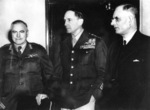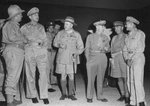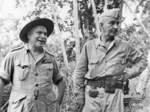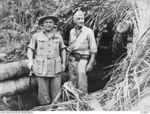Thomas Blamey
| Surname | Blamey |
| Given Name | Thomas |
| Born | 24 Jan 1884 |
| Died | 27 May 1951 |
| Country | Australia |
| Category | Military-Ground |
| Gender | Male |
Contributor: Morgan Bell
ww2dbaseThomas Blamey held the position at the pinnacle of the Australian army during the Second World War - Commander-in-Chief - but his rank was not matched by his achievements on the battlefield, nor equaled by a character that inspired subordinates to feats that they might otherwise not achieve.
ww2dbaseThomas Albert Blamey was born at Lake Albert, near Wagga Wagga, in NSW during 1884, one of ten children. He was raised practicing many of the skills commensurate in the development an important character trait in the mythology of the Aussie digger, skills which included shooting, horse riding, swimming in the lake, droving, and the thirst that these activities gave would be quenched by a cold schooner of beer. The average country-born Australian soldier of both world wars possessed a legendary independence that was noted by superiors in their brave service and by their enemies in their stubborn defiance. While the celebrated image of the Aussie digger is tall, lean and tanned, Blamey was short and stocky. Blamey's father was a jack-of-all-trades proficient in jobs common to rural Australia. Tom occasionally helped him in his work, at age thirteen he rode alone for two hundred miles to deliver a message to his father. Many friends and neighbours remember giving Thomas Blamey gifts of toy soldiers to him in his youth, as his father insisted that they were the only toys the boy would play with. Educated mostly in public schools, Blamey enjoyed cadets, a practice taken from British schools, and quite popular in the colonies. As the Australian colonies of the nineteenth century in time gave way to the federated dominion of the twentieth century, soldiering was emphasized, and the martial glory attained in international conflicts that the promise such an occupation held: even though Blamey would have too young to remember, New South Wales had sent a contingent to aid Britain in the conflict in the Sudan in 1885; With the outbreak of war with the Boers in South Africa in 1899, a fifteen year old Thomas Blamey had tried to enlist in the Boer War with his eighteen year old brother in 1901, but was swiftly rejected by the recruiting sergeant. After witnessing his father's misfortune with the various properties he had owned over the years, Thomas Blamey wanted to pursue a career with plenty of security and opportunity for advancement.
ww2dbaseHe took the examination with the NSW Education Board, becoming a teacher. Being a teacher enabled Blamey to continue involvement in the cadets, this time as an officer. By the time he had ceased working as a teacher in 1906, he had worked his way into the Administrative and Instructional Staff of the cadets, working in offices within the Defence Department in Melbourne. Blamey had always seen this appointment as a doorway to a higher appointment, he was not disappointed when he was transferred to the Administrative and Instructional Staff of the miltia in April 1910. By this time he was firmly settled in a military career, so he applied to the Imperial Staff College of the British Commonwealth, which had opened a college in Quetta, in India, under the advice of Lord Horatio Kitchener. The college could not provide an exact replica of the staff course offered in Camberley, but the same basic outline was provided, and Blamey proved to be a keen student who made a lot of friends in the course of his time there. He had traveled to England to view famous battlefields, an aspect that the campus in Quetta lacked. Blamey was suitably placed during the outbreak of the First World War: there were few senior officers of the Australian army in England with the arrival of war in 1914, he was assigned the position of Intelligence officer, ranking third overall, in the staff of the 1st AIF, in the staff headquarters headed by the AIF Chief of the General Staff, Brudenell White. Blamey did a lot of organizational work for the Australian role in the Gallipoli campaign. As the war progressed, and new Australian chiefs of staff took a role in deciding the direction of Australian operations, Blamey continued his involvement as an officer in the general staff team. Monash recognized Blamey's skill as a member of the operational planning staff.
ww2dbaseUpon return to Australia near the end of the war, Blamey was assigned to postings in the militia, though none as prestigious as the posts he held during the First World War. Blamey wondered if his advancement in the Australian army had halted, if the dazzling career he had begun in the army had ended with the conclusion of the First World War. Blamey was 34, far too young to retire. At this crucial moment, in 1925, Blamey was offered the position of Commissioner of the Victorian police force. The opportunity was too good to refuse. During his eleven year reign in the position Blamey revealed many of the traits he would display during the Second World War. While he encouraged a strong, astute administration below him, and possessed a single-minded ability to push through an agenda, his tenure was marked with controversy. He had a talent for alienating governments, especially those of the Labor variety. The public were outraged by his flouting of two well-known Blamey moral flaws, an imbibing of alcohol and an insatiable lust for disreputable women. He was often publicly spotted breaking the state's restrictive licensing laws. The latter flaw ultimately cost him his job. In what was known as the "Badge 80 Affair", three plain-clothes policemen raided a Fitzroy brothel, finding a policeman with a prostitute in one of the rooms. The number on the badge he displayed, claiming it was his, was Blamey's. Blamey tried to avert controversy by various means: lying, appointing a biased internal investigation, threats against investigators, and acquiring alibis from friends. The three plain-clothes policemen, as well as the madam of the establishment in question, all denied the policeman at the centre of the controversial act was Blamey. However, it was not enough: the suspicion turned his fellow officers, the press, the public and the state government against him. Regardless of individual judgement of Blamey's behaviour, the concern was about how indiscreet he was in causing this controversy. His tenure as Chief Commissioner of the Victorian police force ended in 1936. During his eleven year reign as Victorian Chief Commissioner, Blamey brought improved recruit training procedures, welfare systems and more efficient law enforcement techniques to the state's force. Along with the controversy and successful administrative changes, however, Blamey also felt personal loss. In 1932 one of his sons perished in an aircraft accident, and in 1935 Blamey's wife succumbed to a fatal, debilitating illness. In 1936, at the age of fifty-two, and left with little career prospects, Blamey became commanding officer of the 3rd militia division, returning to a career path he was familiar with. When this post ended in 1937, Blamey became a major-general on the unattached list of the Australian army.
ww2dbaseAfter the Second World War had started, Blamey's military acumen was rediscovered. In 1939 Blamey was appointed chairman of the Commonwealth's Manpower Committee and Controller-General of Recruiting. As the war cabinet began looking for an officer to lead the first echelon of the 2nd AIF, the 6th division, Blamey was discussed. Due to aggressiveness in politico-military relations with the British Blamey was an attractive option to four cabinet ministers, it was believed that Blamey would not condone the British separating AIF divisions. On 13 October 1939 Blamey was appointed commander of the 6th Division, the choice engendering controversy itself: there were other officers more senior than Blamey, such as Gordon Bennett. Bennett took Blamey's appointment personally, habouring resentment against Blamey, believing he had been cheated of the post by Blamey's scheming. Others thought the position should have gone to a permanent officer. Blamey's time as commander of the 6th Division was marked by controversy, while serving in the Middle East he would frequent a Cairo nightclub, where his activities would be obvious to other officers and the troops. While the officers of Lustre Force were escaping Greece, Blamey offered one of the few available seats remaining on the plane to his remaining son, a decision that provoked criticism, however understandable in light of the previous losses in his family during the interwar years. Upon Blamey's return to Australia in 1941 the Curtin government, in light of the Japanese entry into the war, promoted him to the position of commander-in-chief of the Australian Army. Although this move provoked controversy, both amongst his subordinates and the public, who knew of his hard lifestyle, when questioned by journalists Curtin replied "I appointed a military commander, not a Sunday School teacher". When MacArthur arrived in Australia in March 1942, the American general was appointed supreme commander of the SWPA, having the prime minister's ear and holding unparalleled power over military decisions made in Australia. For his part MacArthur disliked Blamey, who was in MacArthur's opinion a "non-professional Australian drunk". The two squabbled like petulant children, whether it was in close proximity or from a distance. The problem was accentuated by the fact that MacArthur had no choice but appoint Blamey as commander of Allied land forces among the SWPA staff, including Americans. When the Japanese appeared poised to take Port Moresby during the Kokoda campaign, MacArthur pressured Blamey to travel to Papua to "energise the situation". Far from energizing the situation, Blamey did what he did best: create controversy. Blamey terminated the commands of at least four competent officers in Papua.
ww2dbaseHe retired to Melbourne after the war, and became Australia's only field marshal on 8 June 1950. Although it is difficult to comprehend how such a controversial figure became a field marshal, the promotion stems from Blamey's role in Australian history. In the three worst historical traumas of the 20th Century for Australian society, Blamey held high command: In the General Staff of the 1st AIF in the First World War; as Chief Commissioner of the Victorian Police during the Depression years; and many important positions during the Second World War. His military knowledge had adapted well through this time, he had been born in an era dominated by horse and cart, yet in his lifetime the changes in military technology had been massive: including massed artillery, chemical weapons, machine guns, planes, tanks, submarines, aircraft carriers, missiles and near the end of his career, atomic weapons.
ww2dbaseSources: D. Horner, Blamey: Commander-In-Chief, Australian War Memorial, P. Brune, A Bastard of a Place: Australians in Papua.
Last Major Revision: Apr 2009
Thomas Blamey Interactive Map
Photographs
 |  |  |  |
Videos
 |
Thomas Blamey Timeline
| 24 Jan 1884 | Thomas Blamey was born. |
| 28 Sep 1939 | The Australian 6th Infantry Division was established under the command of Lieutenant General Thomas Blamey for service overseas. |
| 5 Apr 1941 | All British, Australian and New Zealand forces in Greece came under command of the veteran Australian, General (later Field Marshal Sir) Thomas Blamey to form the 1st Australian Corps. |
| 27 May 1951 | Thomas Blamey passed away. |
Please consider supporting us on Patreon. Even $1 per month will go a long way! Thank you. Please help us spread the word: Stay updated with WW2DB: |
Visitor Submitted Comments
17 Oct 2016 04:39:47 PM
Who knew HIS WIFE sorry caps
3 Apr 2017 09:45:07 PM
I believe he also appointed Leslie Morsehead as CO of the 9th Division, which as we all know, was quite an excellent fighting force, I.E Tobruk and Al Alemein, which adds a positive to his record
All visitor submitted comments are opinions of those making the submissions and do not reflect views of WW2DB.
» New Guinea-Papua Campaign, Phase 3
» Anzac Conference
» Japan's Surrender
Document(s):
» Japanese Instrument of Surrender
- » 1,167 biographies
- » 337 events
- » 44,601 timeline entries
- » 1,243 ships
- » 350 aircraft models
- » 207 vehicle models
- » 376 weapon models
- » 123 historical documents
- » 261 facilities
- » 470 book reviews
- » 28,520 photos
- » 367 maps
Fleet Admiral Chester W. Nimitz, 16 Mar 1945
Please consider supporting us on Patreon. Even $1 a month will go a long way. Thank you!
Or, please support us by purchasing some WW2DB merchandise at TeeSpring, Thank you!
11 Sep 2009 07:51:24 PM
Perhaps your article on Blamey could also include the fact that it was lying to a Royal Commission about a shooting involving one of his detectives that ultimately forced him to resign as Chief Commissioner of Police (rather than the Badge 80 affair).